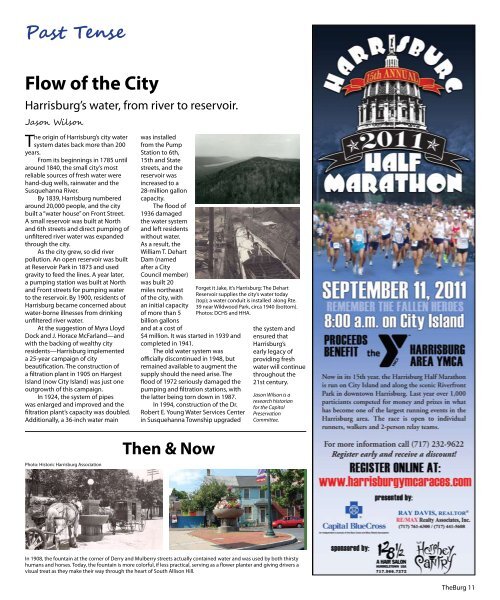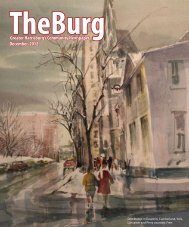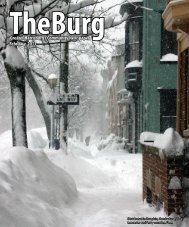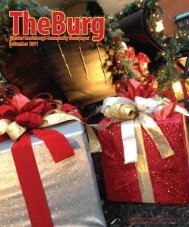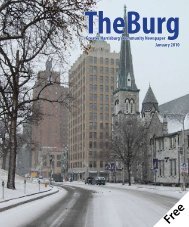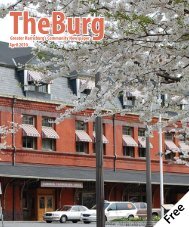August 2011 Greater Harrisburg's Community Newspaper - theBurg
August 2011 Greater Harrisburg's Community Newspaper - theBurg
August 2011 Greater Harrisburg's Community Newspaper - theBurg
You also want an ePaper? Increase the reach of your titles
YUMPU automatically turns print PDFs into web optimized ePapers that Google loves.
Past Tense<br />
Flow of the City<br />
Harrisburg’s water, from river to reservoir.<br />
Jason Wilson<br />
The origin of Harrisburg’s city water<br />
system dates back more than 200<br />
years.<br />
From its beginnings in 1785 until<br />
around 1840, the small city’s most<br />
reliable sources of fresh water were<br />
hand-dug wells, rainwater and the<br />
Susquehanna River.<br />
By 1839, Harrisburg numbered<br />
around 20,000 people, and the city<br />
built a “water house” on Front Street.<br />
A small reservoir was built at North<br />
and 6th streets and direct pumping of<br />
unfiltered river water was expanded<br />
through the city.<br />
As the city grew, so did river<br />
pollution. An open reservoir was built<br />
at Reservoir Park in 1873 and used<br />
gravity to feed the lines. A year later,<br />
a pumping station was built at North<br />
and Front streets for pumping water<br />
to the reservoir. By 1900, residents of<br />
Harrisburg became concerned about<br />
water-borne illnesses from drinking<br />
unfiltered river water.<br />
At the suggestion of Myra Lloyd<br />
Dock and J. Horace McFarland—and<br />
with the backing of wealthy city<br />
residents—Harrisburg implemented<br />
a 25-year campaign of city<br />
beautification. The construction of<br />
a filtration plant in 1905 on Hargest<br />
Island (now City Island) was just one<br />
outgrowth of this campaign.<br />
In 1924, the system of pipes<br />
was enlarged and improved and the<br />
filtration plant’s capacity was doubled.<br />
Additionally, a 36-inch water main<br />
was installed<br />
from the Pump<br />
Station to 6th,<br />
15th and State<br />
streets, and the<br />
reservoir was<br />
increased to a<br />
28-million gallon<br />
capacity.<br />
The flood of<br />
1936 damaged<br />
the water system<br />
and left residents<br />
without water.<br />
As a result, the<br />
William T. Dehart<br />
Dam (named<br />
after a City<br />
Council member)<br />
was built 20<br />
miles northeast<br />
of the city, with<br />
an initial capacity<br />
of more than 5<br />
billion gallons<br />
and at a cost of<br />
$4 million. It was started in 1939 and<br />
completed in 1941.<br />
The old water system was<br />
officially discontinued in 1948, but<br />
remained available to augment the<br />
supply should the need arise. The<br />
flood of 1972 seriously damaged the<br />
pumping and filtration stations, with<br />
the latter being torn down in 1987.<br />
In 1994, construction of the Dr.<br />
Robert E. Young Water Services Center<br />
in Susquehanna Township upgraded<br />
Forget it Jake, it’s Harrisburg: The Dehart<br />
Reservoir supplies the city’s water today<br />
(top); a water conduit is installed along Rte.<br />
39 near Wildwood Park, circa 1940 (bottom).<br />
Photos: DCHS and HHA.<br />
the system and<br />
ensured that<br />
Harrisburg’s<br />
early legacy of<br />
providing fresh<br />
water will continue<br />
throughout the<br />
21st century.<br />
Jason Wilson is a<br />
research historian<br />
for the Capitol<br />
Preservation<br />
Committee.<br />
Photo: Historic Harrisburg Association<br />
Then & Now<br />
In 1908, the fountain at the corner of Derry and Mulberry streets actually contained water and was used by both thirsty<br />
humans and horses. Today, the fountain is more colorful, if less practical, serving as a flower planter and giving drivers a<br />
visual treat as they make their way through the heart of South Allison Hill.<br />
TheBurg 11


